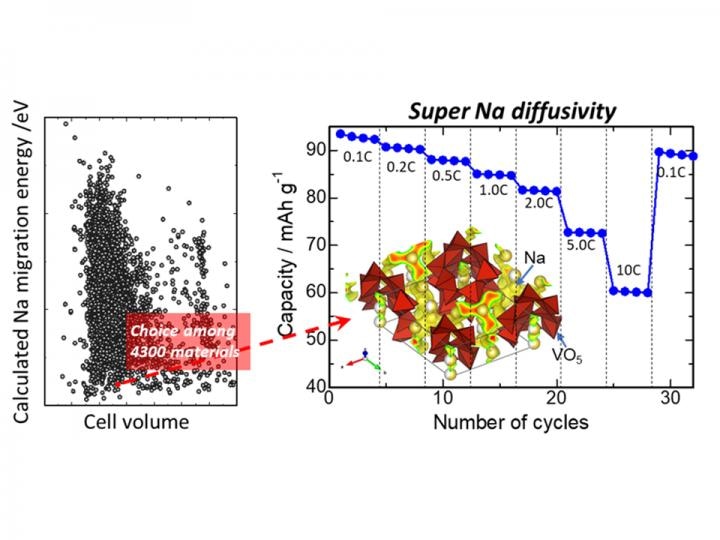Feb 4 2019
Scientists at the Nagoya Institute of Technology (NITech) in Japan have shown that a particular material can serve as an effective battery component for sodium-ion batteries that will compete with lithium-ion batteries for various characteristics of the battery, in particular, the speed of charge.
 A high-throughput computation for Na migration energies is conducted for about 4300 compounds in the inorganic crystal structure database, in which the compound indeed exhibited excellent high-rate performance and cyclic durability; in detail, the compound exhibits stable 10C cycling, which corresponds to the rate of only 6 minutes for full charge/discharge, and ca. 94% capacity retention after 50 charge/discharge cycles at room temperature. These results are comparable with or outperform representative cathode materials for sodium-ion batteries. (Image credit: NITech)
A high-throughput computation for Na migration energies is conducted for about 4300 compounds in the inorganic crystal structure database, in which the compound indeed exhibited excellent high-rate performance and cyclic durability; in detail, the compound exhibits stable 10C cycling, which corresponds to the rate of only 6 minutes for full charge/discharge, and ca. 94% capacity retention after 50 charge/discharge cycles at room temperature. These results are comparable with or outperform representative cathode materials for sodium-ion batteries. (Image credit: NITech)
The discovery led by Naoto Tanibata, PhD, an Assistant Professor at the Department of Advanced Ceramics at NITech, was reported in Scientific Reports in November 2018.
The well-known lithium-ion batteries have many advantages—they can be recharged and have a broad range of application. They are used in devices like cell phones and laptops and also in hybrid and fully electric cars. The electric vehicle—being an important technology to combat pollution in rural areas as well as ushering in clean and sustainable transport—plays a key role in the efforts to solve the energy and environmental issues.
The fact that lithium is an inadequate resource is one drawback to it. It is expensive and also its annual output is (technically) less (because of drying process). With greater demand for battery-powered devices and specifically electric cars, the necessity to find a substitute for lithium—one that is abundant as well as economical—is becoming important.
Sodium-ion batteries are a smart substitute to lithium-based ion batteries for various reasons. Sodium is not a scanty resource—it is found abundantly in seawater and also in the Earth’s crust. In addition, sodium-based components have the potential to yield much quicker charging time provided that it has an ideal crystal structure design. As sodium has a larger ion size and fairly different chemistry, it is not possible to simply swap sodium with lithium used in the existing battery materials. Hence, scientists are tasked with finding the best material for sodium-ion battery among a large number of candidates by trial-and-error method.
Researchers at NITech have found a reasonable and effective method to overcome this problem. After extracting around 4300 compounds from crystal structure database and then a high-throughput computation of the extracted compounds, one of them obtained approving results and was hence a potential candidate as a sodium-ion battery component. The scientists found that Na2V3O7 exhibits desired electrochemical performance as well as electronic and crystal structures. This compound demonstrates rapid charging performance because it can be steadily charged in just 6 minutes. In addition, the scientists showed that the compound results in both long battery life and short charging time.
“Our aim was to tackle the biggest hurdle that large-scale batteries face in applications such as electric cars that heavily rely on long charge durations. We approached the issue via a search that would yield materials efficient enough to increase a battery’s rate performance.”
Although Na2V3O7 has approving characteristics and overall desirable effect on sodium-ion batteries, the scientists found that it suffered deterioration in the final charging stages, which reduces the practical storage capacity to half of the theoretical one. Thus, the scientists intend to focus on enhancing the performance of this material in their future experiments, so that it can remain stable throughout the whole period of the charging stages.
Our ultimate goal is to establish a method that will enable us to efficiently design battery materials via a combination of computational and experimental methods.
Dr Naoto Tanibata, Assistant Professor, Department of Advanced Ceramics, NITech.
The article titled “Nanotube-structured Na2V3O7 as a Cathode Material for Sodium-Ion Batteries with High-rate and Stable Cycle Performance” was published in Scientific Reports.